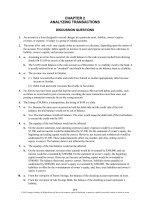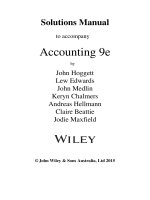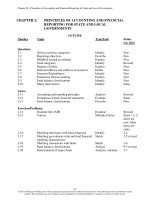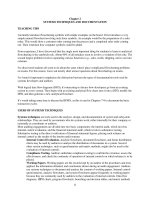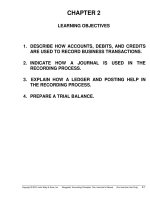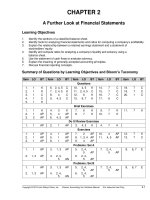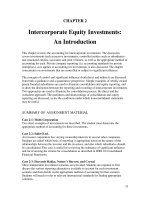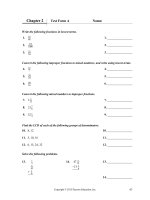Test bank and solution of development psychology (2)
Bạn đang xem bản rút gọn của tài liệu. Xem và tải ngay bản đầy đủ của tài liệu tại đây (353.7 KB, 39 trang )
Chapter 2 Theories of Human Development
MULTIPLE CHOICE
1. Which statement best describes a good scientific theory?
a. It has a large number of explanatory principles.
b. Its tenets explain the phenomenon so well that no new hypotheses need be
formulated.
c. It results in testable predictions.
d. It is narrow in focus and explains only a few specific phenomena.
ANS: C
OBJ: LO 1
PTS: 1
DIF: Factual
TOP: The Nature of Scientific Theories
REF: 41
BLM: Remember
2. Suppose that a new developmental theory builds on existing knowledge by allowing for the
formation of new testable hypotheses. How would this theory be categorized?
a. as parsimonious
b. as heuristic
c. as falsifiable
d. as normative
ANS: B
OBJ: LO 1
PTS: 1
DIF: Conceptual
TOP: The Nature of Scientific Theories
REF: 41
BLM: Remember
3. Suppose that a new developmental theory is one that uses a few principles to account for a
large number of empirical observations. How would this theory be categorized?
a. as parsimonious
b. as heuristic
c. as falsifiable
d. as normative
ANS: A
OBJ: LO 1
PTS: 1
DIF: Conceptual
TOP: The Nature of Scientific Theories
REF: 41
BLM: Remember
4. Edgar proposed a theory to explain children’s learning. Over the years, several other
researchers have tested Edgar’s theory, with mixed results. In recent years, nearly every
attempt at validation has resulted in disconfirmation of Edgar’s theory. At this point, what
should Edgar do?
a. continue to support his theory as it is, because a few disconfirmations do not mean
very much
b. consider revising his theory, because the recent disconfirmations suggest that there
may be problems with the theory
c. discard his theory altogether, because the recent disconfirmations prove that his
theory is incorrect
d. critically evaluate the procedures used in the studies that failed to confirm his
theory in an attempt to uncover flaws in the research procedures
ANS: B
OBJ: LO 1
PTS: 1
DIF: Applied
TOP: The Nature of Scientific Theories
REF: 41
BLM: Higher Order
Copyright © 2013 Nelson Education Ltd.
2-1
Chapter 2 Theories of Human Development
5. Marianna proposed a theory to explain children’s understanding of nature. Over the years, the
predictions of her theory have been tested, with mixed results. Many researchers have
developed their own theories that modify Marianna’s theory. From the information given,
what could you conclude about her theory?
a. It is falsifiable.
b. It is parsimonious.
c. It is heuristic.
d. It is valid.
ANS: C
OBJ: LO 1
PTS: 1
DIF: Applied
TOP: The Nature of Scientific Theories
REF: 41
BLM: Higher Order
6. Luisa proposed a theory that completely explained her observations of children’s development
during an extended visit to a small village in Africa. Luisa’s theory offered no predictions
about future observations in other cultures. How would her theory most likely be labelled?
a. a good theory because it provided clear and complete explanations of her
observations
b. a mediocre theory, because it did not generalize well to other situations
c. a poor theory, because it failed to generate interest from other scientists
d. a failure as a theory, because it was not falsifiable
ANS: D
OBJ: LO 1
PTS: 1
DIF: Applied
TOP: The Nature of Scientific Theories
REF: 41
BLM: Higher Order
7. At what point in the research process are theories developed?
a. after initial observations; they are then adjusted as necessary after further
investigation
b. before extensive research; they are unchanging
c. after initial observations; they are not changed unless there is a change in the
events the theory explains
d. before any observations have been made; they are later evaluated to determine if
the principles hold up to rigorous testing
ANS: A
OBJ: LO 1
PTS: 1
DIF: Factual
TOP: The Nature of Scientific Theories
REF: 41
BLM: Higher Order
8. According to Freud, which component of personality is responsible for perception, learning,
and logical reasoning?
a. the id
b. the ego
c. the superego
d. the collective unconscious
ANS: B
OBJ: LO 2
PTS: 1
DIF: Factual
TOP: The Psychoanalytic Viewpoint
REF: 42
BLM: Remember
Copyright © 2013 Nelson Education Ltd.
2-2
Chapter 2 Theories of Human Development
9. According to Freud, what does the id seek?
a. immediate gratification of innate urges
b. moral perfection
c. appropriate outlets for basic needs while adhering to social constraints
d. self-actualization
ANS: A
OBJ: LO 2
PTS: 1
DIF: Factual
TOP: The Psychoanalytic Viewpoint
REF: 42
BLM: Remember
10. What would govern a person’s behaviour if he or she was under the influence of the id?
a. society’s moral customs
b. inborn instinctual drives
c. memories of the prior context of the action
d. reason and deliberation
ANS: B
OBJ: LO 2
PTS: 1
DIF: Conceptual
TOP: The Psychoanalytic Viewpoint
REF: 42
BLM: Remember
11. According to Freud, what does the ego seek?
a. immediate gratification of innate urges
b. moral perfection
c. appropriate outlets for basic needs while adhering to social constraints
d. self-actualization
ANS: C
OBJ: LO 2
PTS: 1
DIF: Factual
TOP: The Psychoanalytic Viewpoint
REF: 42
BLM: Remember
12. What would govern a person’s behaviour if he or she was under the influence of the
superego?
a. inborn instinctual drives
b. reason and deliberation
c. memories of the prior context of the action
d. society’s moral customs
ANS: D
OBJ: LO 2
PTS: 1
DIF: Factual
TOP: The Psychoanalytic Viewpoint
REF: 42
BLM: Higher Order
13. According to Freud, what does the superego seek?
a. self-actualization
b. immediate gratification of innate urges
c. appropriate outlets for basic needs while adhering to social constraints
d. moral perfection
ANS: D
OBJ: LO 2
PTS: 1
DIF: Factual
TOP: The Psychoanalytic Viewpoint
REF: 42
BLM: Remember
Copyright © 2013 Nelson Education Ltd.
2-3
Chapter 2 Theories of Human Development
14. According to Freud, what is the dominant force that shapes a healthy personality?
a. the ego
b. the superego
c. the id, ego, and the collective unconscious in dynamic balance
d. the ego, superego, and id in dynamic balance
ANS: D
OBJ: LO 2
PTS: 1
DIF: Factual
TOP: The Psychoanalytic Viewpoint
REF: 42
BLM: Remember
15. According to Freud, which aspect of personality is the conscious, rational component?
a. the superego
b. the ego
c. the id
d. the collective unconscious
ANS: B
OBJ: LO 2
PTS: 1
DIF: Factual
TOP: The Psychoanalytic Viewpoint
REF: 42
BLM: Remember
16. Two-year-old Letitia throws a temper tantrum. According to Freud, which part of Letitia’s
personality exerted control during her tantrum?
a. her superego
b. her ego
c. her id
d. her conscience
ANS: C
OBJ: LO 2
PTS: 1
DIF: Applied
TOP: The Psychoanalytic Viewpoint
REF: 42
BLM: Remember
17. Suppose that Irene wants to have a bracelet that she saw in a store, but she doesn’t have the
money to buy it. Irene doesn’t care that she has no money so she steals the bracelet.
According to Freud, which component of Irene’s personality was responsible for her theft?
a. her anal complex
b. her superego
c. her Electra complex
d. her id
ANS: D
OBJ: LO 2
PTS: 1
DIF: Applied
TOP: The Psychoanalytic Viewpoint
REF: 42
BLM: Higher Order
18. Suppose that Steve wants to have a CD that he saw in a store, but he doesn’t have the money
to buy it. Although Steve feels he should be able to have the CD, he recognizes that taking
something that he can’t pay for is wrong. According to Freud, which component of Steve’s
personality would resolve these competing goals?
a. his collective unconscious
b. his superego
c. his ego
d. his id
ANS: C
OBJ: LO 2
PTS: 1
DIF: Applied
TOP: The Psychoanalytic Viewpoint
REF: 43
BLM: Higher Order
Copyright © 2013 Nelson Education Ltd.
2-4
Chapter 2 Theories of Human Development
19. David lies, steals, and cheats routinely. According to Freud’s theory, what would you
conclude about David’s personality structure?
a. He has a weak id.
b. He has a weak ego.
c. He has a strong ego.
d. He has a strong id.
ANS: D
OBJ: LO 2
PTS: 1
DIF: Applied
TOP: The Psychoanalytic Viewpoint
REF: 43
BLM: Higher Order
20. According to Freud, what causes a child to enter a new psychosexual stage of development?
a. There is a shift in which part of the body is the focus of pleasure.
b. The id has become a more powerful force in the child’s life.
c. The id has become a less powerful force in the child’s life.
d. The type of pleasure received from the genitals has changed.
ANS: A
OBJ: LO 3
PTS: 1
DIF: Factual
TOP: The Psychoanalytic Viewpoint
REF: 43
BLM: Remember
21. In Freud’s conception of psychosexual development, during which developmental phase does
the phallic stage begin?
a. infancy
b. toddlerhood
c. preschool to early elementary
d. puberty
ANS: C
OBJ: LO 3
PTS: 1
DIF: Conceptual
TOP: The Psychoanalytic Viewpoint
REF: 43
BLM: Higher Order
22. According to Freud, which stage of personality development begins at age 5 and lasts until the
onset of puberty?
a. oral
b. anal
c. latency
d. phallic
ANS: C
OBJ: LO 3
PTS: 1
DIF: Factual
TOP: The Psychoanalytic Viewpoint
REF: 43
BLM: Remember
23. Chris smokes heavily, overeats, and needs a lot of reassurance from his wife that she still
loves him. Based on Freud’s theory, we might expect to find that Chris had some type of
trauma during which stage of psychosexual development?
a. oral
b. anal
c. phallic
d. genital
ANS: A
OBJ: LO 3
PTS: 1
DIF: Applied
TOP: The Psychoanalytic Viewpoint
REF: 43
BLM: Higher Order
Copyright © 2013 Nelson Education Ltd.
2-5
Chapter 2 Theories of Human Development
24. While Kyle’s mother was toilet training him, she punished Kyle whenever he had an
“accident.” According to Freud’s theory, what would be the outcome of this punishment for
Kyle’s personality?
a. Kyle would be unaffected by being punished because that is how children learn
from their mistakes.
b. Kyle might be withdrawn and need constant reassurance about his worth.
c. Kyle might be anxious, inhibited, and somewhat messy.
d. Kyle might be unable to form relationships with women because they do not
compare to his mother.
ANS: C
OBJ: LO 3
PTS: 1
DIF: Applied
TOP: The Psychoanalytic Viewpoint
REF: 43
BLM: Higher Order
25. Four-year-old Michael often tells his older sister that “Mommy and me are going to get
married when I grow up.” Which of Freud’s stages of personality development is Michael’s
behaviour consistent with?
a. anal
b. phallic
c. latency
d. genital
ANS: D
OBJ: LO 3
PTS: 1
DIF: Applied
TOP: The Psychoanalytic Viewpoint
REF: 43
BLM: Remember
26. What was one of Freud’s most important contributions to our understanding of human
behaviour?
a. his discovery of the Oedipal complex
b. his emphasis on puberty
c. his emphasis on unconscious motivation
d. his discovery of the active role of the child
ANS: C
OBJ: LO 4
PTS: 1
DIF: Conceptual
TOP: The Psychoanalytic Viewpoint
REF: 44
BLM: Remember
27. Freud was one of the first theorists to focus attention on which of the following?
a. the influence of early experiences on later development
b. the active role that children play in their own development
c. the development of cognition and information processing
d. the ways in which environmental consequences could modify behaviour
ANS: A
OBJ: LO 4
PTS: 1
DIF: Factual
TOP: The Psychoanalytic Viewpoint
REF: 44
BLM: Remember
Copyright © 2013 Nelson Education Ltd.
2-6
Chapter 2 Theories of Human Development
28. Compared to Freud’s psychosexual theory, Erikson’s theory of personality placed more
emphasis on which personality structure?
a. the id
b. the ego
c. the superego
d. the collective unconscious
ANS: B
OBJ: LO 5
PTS: 1
DIF: Factual
TOP: The Psychoanalytic Viewpoint
REF: 44
BLM: Remember
29. In comparison to Freud’s emphases in his psychosexual theory of personality development,
what did Erikson emphasize in his psychosocial theory?
a. the passive role of children who are moulded by social influences
b. the ego and the active role of children in their own social development
c. the role of biological and sexual urges in conjunction with social influences
d. the id and the social influence of parental behaviour and attitudes
ANS: B
OBJ: LO 5
PTS: 1
DIF: Conceptual
TOP: The Psychoanalytic Viewpoint
REF: 44
BLM: Remember
30. What is one basic distinction between the views of Freud and Erikson?
a. Freud thought development was stage-like whereas Erikson saw it as continuous.
b. Freud emphasized the “nurture” side of development whereas Erikson emphasized
the “nature” side of development.
c. Freud emphasized the role of biological forces in development whereas Erikson
emphasized the role of social and cultural forces in development.
d. Freud believed the transitions between successive stages were gradual whereas
Erikson believed the transitions were more sharply defined and identifiable.
ANS: C
OBJ: LO 5
PTS: 1
DIF: Conceptual
TOP: The Psychoanalytic Viewpoint
REF: 44
BLM: Remember
31. Each of Erikson’s eight stages reflects a conflict that arises because of biological maturation
and which of the following?
a. the child’s demands
b. social demands
c. id development
d. ego development
ANS: B
OBJ: LO 6
PTS: 1
DIF: Factual
TOP: The Psychoanalytic Viewpoint
REF: 44
BLM: Remember
32. Erikson believed that humans face eight major crises over their lifetime. What are the two
factors that determine when each crisis occurs and the nature of the crisis?
a. sexual maturation and life stresses
b. sexual maturation and conflicts between the id and superego
c. biological maturation and social demands
d. life stresses and the responsiveness of sexual partners
ANS: C
OBJ: LO 6
PTS: 1
DIF: Factual
TOP: The Psychoanalytic Viewpoint
REF: 44
BLM: Remember
Copyright © 2013 Nelson Education Ltd.
2-7
Chapter 2 Theories of Human Development
33. According to Erikson, which parental characteristic is the most important aspect for the
development of trust?
a. disciplinary strategies
b. warmth
c. responsiveness to the infant’s needs
d. assertiveness
ANS: C
OBJ: LO 6
PTS: 1
DIF: Factual
TOP: The Psychoanalytic Viewpoint
REF: 45
BLM: Remember
34. According to Erikson’s theory, a child who is very suspicious of others and who views the
world as a dangerous place did not successfully resolve which crisis?
a. basic trust versus mistrust
b. autonomy versus shame and doubt
c. initiative versus guilt
d. industry versus inferiority
ANS: A
OBJ: LO 6
PTS: 1
DIF: Conceptual
TOP: The Psychoanalytic Viewpoint
REF: 45
BLM: Remember
35. Preschoolers and early elementary school children are learning to take initiative and are trying
new tasks. According to Erikson, what type of parent fosters healthy development during this
time?
a. one who lets the child do what he or she wants
b. one who neither encourages nor discourages initiative
c. one who punishes initiative behaviours
d. one who helps achieve a balance between initiative taking and respecting others
ANS: D
OBJ: LO 6
PTS: 1
DIF: Conceptual
TOP: The Psychoanalytic Viewpoint
REF: 45
BLM: Remember
36. Yolanda has just celebrated her second birthday. According to Erikson’s theory, which life
crisis is likely to be most relevant to Yolanda over the next few years?
a. autonomy versus shame and doubt
b. intimacy versus isolation
c. basic trust versus mistrust
d. industry versus inferiority
ANS: A
OBJ: LO 6
PTS: 1
DIF: Applied
TOP: The Psychoanalytic Viewpoint
REF: 45
BLM: Higher Order
Copyright © 2013 Nelson Education Ltd.
2-8
Chapter 2 Theories of Human Development
37. Brett is 25 years old and has not yet decided what he wants to do with his life. He changed
majors in college three times in the last two years and he has considered dropping out of
college altogether. According to Erikson, which crisis has Brett failed to resolve?
a. identity versus confusion
b. autonomy versus shame and doubt
c. basic trust versus mistrust
d. industry versus inferiority
ANS: A
OBJ: LO 6
PTS: 1
DIF: Applied
TOP: The Psychoanalytic Viewpoint
REF: 45
BLM: Higher Order
38. In the classic tale of A Christmas Carol, a transformation took place in Scrooge despite his
advanced age. In this tale, he eventually acquired a sense of intimacy and generativity.
According to Erikson, is this type of happy ending typical?
a. yes, because adult experiences can remedy unsatisfactory early resolutions to
crises
b. yes, because early experience has little carryover to our adult personality
c. no, because unresolved early crises cannot be remedied later in life
d. no, because it is rare for individuals to achieve the sense of generativity that
Erickson described.
ANS: A
OBJ: LO 7
PTS: 1
DIF: Applied
TOP: The Psychoanalytic Viewpoint
REF: 45
BLM: Higher Order
39. What did the neo-Freudian theorist Karen Horney emphasize as an important factor in
development?
a. sex differences
b. birth order
c. sibling interactions
d. the collective unconscious
ANS: A
OBJ: LO 7
PTS: 1
DIF: Factual
TOP: The Psychoanalytic Viewpoint
REF: 46
BLM: Remember
40. What did the neo-Freudian theorist Alfred Adler emphasize as an important factor in
development?
a. sex differences
b. birth order
c. sibling interactions
d. the collective unconscious
ANS: C
OBJ: LO 7
PTS: 1
DIF: Factual
TOP: The Psychoanalytic Viewpoint
REF: 46
BLM: Remember
Copyright © 2013 Nelson Education Ltd.
2-9
Chapter 2 Theories of Human Development
41. What did the neo-Freudian theorist Harry Stack Sullivan emphasize as an important factor in
development?
a. sex differences
b. close same-sex friendships
c. the collective unconscious
d. number of siblings
ANS: B
OBJ: LO 7
PTS: 1
DIF: Factual
TOP: The Psychoanalytic Viewpoint
REF: 46
BLM: Remember
42. What is one basic distinction between the views of John Watson and Sigmund Freud?
a. Watson believed that development was continuous whereas Freud saw it as
stage-like.
b. Watson emphasized the “nature” side of development whereas Freud emphasized
the “nurture” side of development.
c. Watson emphasized the role of biological forces in development whereas Freud
emphasized the role of sociocultural forces in development.
d. Watson saw children as having an active role in their own development whereas
Freud saw children as more passive.
ANS: A
OBJ: LO 8
PTS: 1
DIF: Conceptual
TOP: The Learning Viewpoint
REF: 46
BLM: Remember
43. How did John Watson view the child?
a. as an inherently moral being who should be left alone to follow his or her own
natural inclinations
b. as an inherently sinful creature who should be controlled
c. as a blank slate who should be treated firmly and never coddled
d. as a blank slate who should be left alone to explore the environment
ANS: C
OBJ: LO 8
PTS: 1
DIF: Factual
TOP: The Learning Viewpoint
REF: 46
BLM: Remember
44. Which type of developmental change do learning theorists emphasize?
a. qualitative
b. continuous
c. ecologically valid
d. discontinuous
ANS: B
OBJ: LO 8
PTS: 1
DIF: Conceptual
TOP: The Learning Viewpoint
REF: 46
BLM: Remember
45. Which statement best characterizes how the behavioural learning viewpoint views
development?
a. as active, discontinuous, and dependent on external stimuli
b. as active, continuous, and dependent on internal forces.
c. as passive, continuous, and dependent on external stimuli
d. as passive, discontinuous, qualitative, and dependent on internal forces
ANS: C
OBJ: LO 8
PTS: 1
DIF: Conceptual
TOP: The Learning Viewpoint
REF: 46
BLM: Higher Order
Copyright © 2013 Nelson Education Ltd.
2-10
Chapter 2 Theories of Human Development
46. According to the behaviourist John Watson, how should parents respond to their child?
a. permissively, giving the child whatever is requested
b. gently and with resigned acceptance
c. firmly, as if the child is innately sinful
d. firmly, as if the child were a little adult
ANS: D
OBJ: LO 8
PTS: 1
DIF: Factual
TOP: The Learning Viewpoint
REF: 47
BLM: Remember
47. Andrea is a developmental psychologist who has just discovered she is pregnant with her first
child. She plans to raise her child using the principles advocated by John Watson. Which
practice(s) would Andrea need to avoid to meet her goal?
a. providing the infant with educational toys
b. taking the infant out for long walks
c. talking to the infant and pointing out the animals in a picture book
d. kissing, cuddling, and holding the infant in her lap
ANS: D
OBJ: LO 8
PTS: 1
DIF: Applied
TOP: The Learning Viewpoint
REF: 47
BLM: Higher Order
48. According to which theorist are actions strengthened by reinforcers and weakened by
punishers?
a. Vygotsky
b. Skinner
c. Piaget
d. Bowlby
ANS: B
OBJ: LO 9
PTS: 1
DIF: Factual
TOP: The Learning Viewpoint
REF: 47
BLM: Remember
49. What is the term for any event or stimulus that increases the frequency of the behaviour that it
follows?
a. conditioned stimulus
b. punisher
c. reinforcer
d. unconditioned stimulus
ANS: C
OBJ: LO 9
PTS: 1
DIF: Factual
TOP: The Learning Viewpoint
REF: 47
BLM: Remember
50. What is the term for any event or stimulus that decreases the frequency of the behaviour that it
follows?
a. punisher
b. conditioned stimulus
c. reinforcer
d. unconditioned stimulus
ANS: A
OBJ: LO 9
PTS: 1
DIF: Factual
TOP: The Learning Viewpoint
REF: 47
BLM: Remember
Copyright © 2013 Nelson Education Ltd.
2-11
Chapter 2 Theories of Human Development
51. According to Skinner, under what conditions does a stimulus become a reinforcer?
a. when it decreases a biological need
b. when it increases the strength of the superego
c. when it increases the probability of a response
d. when it decreases the probability of a response
ANS: C
OBJ: LO 9
PTS: 1
DIF: Factual
TOP: The Learning Viewpoint
REF: 47
BLM: Remember
52. Tyler asked his father for a candy bar at the grocery store, and his father bought him the candy
bar. If Tyler asks for more candy bars in the future, what has the candy bar acted as?
a. a reinforcer
b. a discriminative stimulus
c. a conditioned stimulus
d. an unconscious motivator
ANS: A
OBJ: LO 9
PTS: 1
DIF: Applied
TOP: The Learning Viewpoint
REF: 47
BLM: Higher Order
53. Michael is pleased to find that his daughter Samantha has already started dinner. He shows his
appreciation by spending the hour after dinner playing her favourite game. The same thing
happens several days later, and soon Samantha is starting dinner on a regular basis. According
to Skinner, what accounts for the change in Samantha’s behaviour?
a. observational learning
b. reinforcement
c. punishment
d. ego reconstruction
ANS: B
OBJ: LO 9
PTS: 1
DIF: Applied
TOP: The Learning Viewpoint
REF: 47
BLM: Higher Order
54. Carmen was ridiculed by her friends when she wore a sweater to school that she had made
herself. Now she no longer wears that sweater. According to Skinner, what process is
represented by the ridicule?
a. reinforcement
b. conditioned stimulation
c. punishment
d. internal drive
ANS: C
OBJ: LO 9
PTS: 1
DIF: Applied
TOP: The Learning Viewpoint
REF: 47
BLM: Higher Order
Copyright © 2013 Nelson Education Ltd.
2-12
Chapter 2 Theories of Human Development
55. Your spouse becomes moody and stops paying attention to you every time you start to
criticize the way that he or she drives. Eventually you stop criticizing your spouse’s driving.
What might Skinner suggest that the withdrawal of attention acted as?
a. a punisher
b. a conditioned stimulus
c. a reinforcer
d. an internal drive
ANS: A
OBJ: LO 9
PTS: 1
DIF: Applied
TOP: The Learning Viewpoint
REF: 47
BLM: Higher Order
56. According to Skinner, what are the primary motivators of behaviour?
a. internal drives
b. maturational forces
c. contingent external stimuli
d. increasingly complex cognitive schemes
ANS: C
OBJ: LO 9
PTS: 1
DIF: Factual
TOP: The Learning Viewpoint
REF: 48
BLM: Remember
57. Bandura was among the first to point out the potential for learning through observation. What
factor did Bandura emphasize to account for this ability?
a. maturation
b. experience
c. reinforcement
d. cognitive processes
ANS: D
OBJ: LO 10
PTS: 1
DIF: Factual
TOP: The Learning Viewpoint
REF: 48
BLM: Remember
58. Which type of learning did Bandura emphasize as an important means of increasing a child’s
behavioural repertoire?
a. operant conditioning
b. behaviourism
c. contingent reinforcement
d. observational learning
ANS: D
OBJ: LO 10
PTS: 1
DIF: Factual
TOP: The Learning Viewpoint
REF: 48
BLM: Remember
59. What is one key difference between Bandura’s and Skinner’s views of development?
a. Bandura believes reinforcers and punishers have little effect on behaviour.
b. Bandura believes reinforcers are more effective than punishers in shaping
behaviour.
c. Bandura believes people anticipate the consequences that are likely to follow their
behaviour.
d. Bandura believes people will often work harder to obtain a small reward than they
will to obtain a large reward.
ANS: C
OBJ: LO 10
PTS: 1
DIF: Conceptual
TOP: The Learning Viewpoint
REF: 48
BLM: Remember
Copyright © 2013 Nelson Education Ltd.
2-13
Chapter 2 Theories of Human Development
60. Hilary is driving on a busy highway with her 3-year-old daughter in the car. Suddenly, another
car cuts them off and Hilary swears as she slams on the brakes. A few weeks later, the same
thing happens and her daughter swears loudly. Hilary is horrified and can’t imagine where her
daughter learned those words. Which theorist would be most accurate at explaining her
daughter’s behaviour?
a. Skinner
b. Bandura
c. Piaget
d. Adler
ANS: B
OBJ: LO 10
PTS: 1
DIF: Applied
TOP: The Learning Viewpoint
REF: 48
BLM: Higher Order
61. Which of these would be a suitable slogan for Albert Bandura’s cognitive social learning
theory?
a. “Genius is 1 percent inspiration and 99 percent perspiration.”
b. “Monkey see, monkey do.”
c. “Great ideas exist as seeds in the minds of newborns.”
d. “Give me a dozen healthy newborns, and I will direct their development toward
any occupations I choose.”
ANS: B
OBJ: LO 10
PTS: 1
DIF: Applied
TOP: The Learning Viewpoint
REF: 48
BLM: Higher Order
62. “We learn by watching and copying others’ actions.” This statement would be most likely
endorsed by proponents of which theory?
a. ethological
b. sociocultural
c. cognitive social learning
d. information-processing
ANS: C
OBJ: LO 10
PTS: 1
DIF: Conceptual
TOP: The Learning Viewpoint
REF: 48
BLM: Higher Order
63. Normand has just found his 10-year-old daughter smoking a cigarette in the garage. He is very
angry and cannot understand where she learned to smoke. When Normand questions his
daughter, she replies that she saw her babysitter smoking and thought it would be fun to try.
How would Bandura explain his daughter’s behaviour?
a. Behaviour is modified through direct environmental consequences.
b. Children learn from observation.
c. Behaviour is modified through unconscious motivations.
d. Children play a passive role in their own development.
ANS: B
OBJ: LO 10
PTS: 1
DIF: Applied
TOP: The Learning Viewpoint
REF: 48
BLM: Remember
Copyright © 2013 Nelson Education Ltd.
2-14
Chapter 2 Theories of Human Development
64. How does Bandura’s version of social learning theory differ from other learning theories?
a. He stressed the role of primary reinforcers more than secondary reinforcers.
b. He ignored the cognitive aspects of learning.
c. He maintained that most learning occurs without reinforcement.
d. He equated learning and performance.
ANS: C
OBJ: LO 10
PTS: 1
DIF: Conceptual
TOP: The Learning Viewpoint
REF: 48
BLM: Remember
65. The notion of reciprocal determinism emphasizes the role of which factor in human
development?
a. unconscious motivation
b. human–environment interactions
c. adaptive schemes
d. evolutionary forces
ANS: B
OBJ: LO 11
PTS: 1
DIF: Factual
TOP: The Learning Viewpoint
REF: 50
BLM: Remember
66. Which statement would be endorsed by a theorist who supported the notion of reciprocal
determinism?
a. Children can learn by observing the behaviour of others.
b. Environment affects the child but the child’s behaviour also affects the
environment.
c. Children are passive learners whose behaviour is determined by environmental
factors.
d. Children are active learners whose behaviour is determined by environment and
heredity.
ANS: B
OBJ: LO 11
PTS: 1
DIF: Conceptual
TOP: The Learning Viewpoint
REF: 50
BLM: Higher Order
67. According to the principle of reciprocal determinism, what would cause one boy in a group to
become a bully?
a. He is naturally aggressive and seeks dominance because he is a male.
b. Other children in the group probably ignored the boy and made him angry.
c. He is more physically mature than the others in the group.
d. Other children in the group become afraid of the bully, permitting him to bully
them.
ANS: D
OBJ: LO 11
PTS: 1
DIF: Conceptual
TOP: The Learning Viewpoint
REF: 50
BLM: Higher Order
Copyright © 2013 Nelson Education Ltd.
2-15
Chapter 2 Theories of Human Development
68. According to the text, what is one criticism that has been raised about the approaches to
studying development utilized by learning theorists?
a. They rely too heavily on constructs that are difficult to define or measure
objectively.
b. They have little applicability outside controlled, laboratory settings.
c. They fail to use adequate controls in the experiments that are undertaken.
d. They emphasize an overly simplified view of human development.
ANS: D
OBJ: LO 12
PTS: 1
DIF: Conceptual
TOP: The Learning Viewpoint
REF: 51
BLM: Remember
69. What is one of the major criticisms of the classic learning viewpoint?
a. it provides relatively little information about infant development
b. its emphasis on biological maturation
c. its oversimplified account of the environmental factors that influence human
development
d. many of its principles cannot be applied to real-life situations
ANS: C
OBJ: LO 12
PTS: 1
DIF: Conceptual
TOP: The Learning Viewpoint
REF: 51
BLM: Remember
70. Which theorist has been a driving force to our understanding of a child’s intellectual
development?
a. Bandura
b. Piaget
c. Bronfenbrenner
d. Freud
ANS: B
OBJ: LO 15
BLM: Remember
PTS: 1
DIF: Factual
REF: 53
TOP: The Cognitive-Developmental Viewpoint
71. Why was Piaget especially interested in the incorrect answers that children gave to his
questions?
a. They supported his theory that children have little innate knowledge and must be
taught everything.
b. They supported his theory that children are incapable of learning at some points in
development.
c. They showed that younger children do not merely know less, but they think
differently from older children.
d. They supported his theory that young children used the same thought processes as
older children, but lacked the memory capacity to process information effectively.
ANS: C
PTS: 1
DIF: Conceptual REF: 53
OBJ: LO 13
TOP: The Cognitive-Developmental Viewpoint
BLM: Higher Order
Copyright © 2013 Nelson Education Ltd.
2-16
Chapter 2 Theories of Human Development
72. Piaget was the first modern-day developmental theorist to stress which of the following?
a. stages of development
b. the influence of motivation on cognition
c. the role of emotions in thinking
d. the active role of children in development
ANS: D
OBJ: LO 13
BLM: Remember
PTS: 1
DIF: Factual
REF: 53
TOP: The Cognitive-Developmental Viewpoint
73. What is the focus of Piaget’s theory?
a. biological maturation
b. psychological maturation
c. social development
d. cognitive development
ANS: D
OBJ: LO 13
BLM: Remember
PTS: 1
DIF: Factual
REF: 53
TOP: The Cognitive-Developmental Viewpoint
74. What is Piaget’s term for an organized pattern of thought or action?
a. stage
b. equilibration
c. assimilation
d. scheme
ANS: D
OBJ: LO 13
BLM: Remember
PTS: 1
DIF: Factual
REF: 53
TOP: The Cognitive-Developmental Viewpoint
75. According to Piaget’s theory of cognitive development, through what process do children
acquire new knowledge?
a. active construction based on their experiences
b. observational learning
c. adult instruction, e.g., demonstrations and explanations
d. punishment and reward
ANS: A
PTS: 1
DIF: Factual
REF: 53
OBJ: LO 13
TOP: The Cognitive-Developmental Viewpoint
BLM: Higher Order
76. According to Piaget, why do children create erroneous notions about the world?
a. They often do not pay close enough attention to the explanations adults give.
b. They do not receive explanations from parents.
c. They lack curiosity.
d. They base their notions on their current understanding of their experiences.
ANS: D
PTS: 1
DIF: Conceptual REF: 53
OBJ: LO 13
TOP: The Cognitive-Developmental Viewpoint
BLM: Higher Order
Copyright © 2013 Nelson Education Ltd.
2-17
Chapter 2 Theories of Human Development
77. With which statement would Piaget most likely agree?
a. Intelligence can be measured by paper-and-pencil tests.
b. The individual constructs his or her reality from interacting with the environment.
c. Thought structures do not change, only the environment does.
d. Cognitive growth is characterized by continuous developmental change.
ANS: B
PTS: 1
DIF: Conceptual REF: 54
OBJ: LO 13
TOP: The Cognitive-Developmental Viewpoint
BLM: Higher Order
78. According to Piaget, what are adaptive, intelligent interactions dependent on?
a. assimilation
b. accommodation
c. assimilation and accommodation working in a complementary fashion
d. mental maturity due to maturation
ANS: C
OBJ: LO 13
BLM: Remember
PTS: 1
DIF: Conceptual REF: 54
TOP: The Cognitive-Developmental Viewpoint
79. According to Piaget, which of the following best describes the process of assimilation?
a. existing schemes are changed or modified to make sense of new experiences
b. recognition that objects continue to exist when they cannot be seen
c. failure to centre on a single aspect of a problem
d. new experiences are incorporated into existing schemes
ANS: D
OBJ: LO 13
BLM: Remember
PTS: 1
DIF: Factual
REF: 54
TOP: The Cognitive-Developmental Viewpoint
80. Often new environments and experiences have characteristics in common with experiences
people have encountered in the past. According to Piaget, in these types of situations, which
adaptive process is used to respond appropriately?
a. accommodation
b. conservation
c. assimilation
d. centration
ANS: C
PTS: 1
DIF: Conceptual REF: 54
OBJ: LO 13
TOP: The Cognitive-Developmental Viewpoint
BLM: Higher Order
Copyright © 2013 Nelson Education Ltd.
2-18
Chapter 2 Theories of Human Development
81. Five-year-old Michael visits a farm for the first time and mistakes the cows he sees there for
horses, like those he has seen on television. According to Piaget, which process does
Michael’s error exemplify?
a. accommodation
b. object permanence
c. centration
d. assimilation
ANS: D
PTS: 1
DIF: Applied
REF: 54
OBJ: LO 13
TOP: The Cognitive-Developmental Viewpoint
BLM: Higher Order
82. According to Piaget, which of the following best describes the process of accommodation?
a. new experiences are incorporated into existing schemes
b. existing schemes are changed or modified to make sense of new experiences
c. recognition that objects continue to exist when they cannot be seen
d. failure to centre on a single aspect of a problem
ANS: B
OBJ: LO 13
BLM: Remember
PTS: 1
DIF: Factual
REF: 54
TOP: The Cognitive-Developmental Viewpoint
83. According to Piaget, people would not respond in new ways to changes in the environment
without which cognitive process?
a. accommodation
b. assimilation
c. conservation
d. centration
ANS: A
OBJ: LO 13
BLM: Remember
PTS: 1
DIF: Conceptual REF: 54
TOP: The Cognitive-Developmental Viewpoint
84. Eight-year-old Charlotte thought all nurses were young females until a middle-aged male
nurse took her temperature and pulse in the hospital. The change in Charlotte’s understanding
of who nurses can be illustrates which Piagetian process?
a. accommodation
b. assimilation
c. object permanence
d. centration
ANS: A
PTS: 1
DIF: Applied
REF: 54
OBJ: LO 13
TOP: The Cognitive-Developmental Viewpoint
BLM: Higher Order
Copyright © 2013 Nelson Education Ltd.
2-19
Chapter 2 Theories of Human Development
85. Colin has just told his mother that his stuffed bear is alive and that the bear hurts because he
knocked it over. How is Colin including the bear in his cognitive schemes?
a. He is assimilating the bear into his existing cognitive schemes.
b. He is accommodating the bear into his existing cognitive schemes.
c. He is accommodating the bear into new cognitive schemes.
d. He is assimilating the bear into new cognitive schemes.
ANS: A
PTS: 1
DIF: Applied
REF: 54
OBJ: LO 13
TOP: The Cognitive-Developmental Viewpoint
BLM: Higher Order
86. According to Piaget, during which stage of cognitive development are children less likely to
be fooled by appearances, and to become more proficient at inferring motives for other
people’s behaviour?
a. concrete operational
b. preoperational
c. sensorimotor
d. formal operational
ANS: A
OBJ: LO 14
BLM: Remember
PTS: 1
DIF: Conceptual REF: 55
TOP: The Cognitive-Developmental Viewpoint
87. Florence has just celebrated her fourth birthday. Based on Piaget’s theory, which stage of
cognitive development would Florence be in?
a. formal operational
b. concrete operational
c. sensorimotor
d. preoperational
ANS: D
OBJ: LO 14
BLM: Remember
PTS: 1
DIF: Applied
REF: 54-55
TOP: The Cognitive-Developmental Viewpoint
88. What type of theorist was Piaget?
a. a stage theorist who maintained that children played an active role in their own
development
b. a stage theorist who maintained that children played a passive role in their own
development
c. an information-processing theorist who maintained that children played an active
role in their own development
d. an information-processing theorist who maintained that children played a passive
role in their own development
ANS: A
OBJ: LO 15
BLM: Remember
PTS: 1
DIF: Factual
REF: 55
TOP: The Cognitive-Developmental Viewpoint
Copyright © 2013 Nelson Education Ltd.
2-20
Chapter 2 Theories of Human Development
89. Piaget’s theory has had a strong impact on education. Which educational program is based on
his findings?
a. guided participation
b. computer-aided instruction
c. multicultural assimilation
d. discovery-based education
ANS: D
OBJ: LO 15
BLM: Remember
PTS: 1
DIF: Factual
REF: 55
TOP: The Cognitive-Developmental Viewpoint
90. Which area of developmental research did Piaget’s research contribute immensely to?
a. social cognition
b. information processing
c. evolutionary psychology
d. reciprocal determinism
ANS: A
OBJ: LO 15
BLM: Remember
PTS: 1
DIF: Factual
REF: 55
TOP: The Cognitive-Developmental Viewpoint
91. What is one of the key criticisms of Piaget’s theory of cognitive development?
a. He focused too much attention on physiological processes.
b. He regularly underestimated the intellectual capabilities of young children.
c. He failed to consider the active role that children play in their own development.
d. He focused too much attention on role models in directing development.
ANS: B
OBJ: LO 15
BLM: Remember
PTS: 1
DIF: Factual
REF: 55
TOP: The Cognitive-Developmental Viewpoint
92. Which theorist emphasized the importance of social interactions with peers in a child’s
cognitive development?
a. Sigmund Freud
b. Konrad Lorenz
c. Lev Vygotsky
d. Karen Horney
ANS: C
OBJ: LO 16
BLM: Remember
PTS: 1
DIF: Factual
REF: 56
TOP: The Cognitive-Developmental Viewpoint
93. According to Vygotsky’s sociocultural perspective, when do children learn best?
a. They are mildly punished for making mistakes.
b. They are given expert guidance by teachers.
c. They discover new ideas on their own.
d. They are rewarded consistently for success.
ANS: B
OBJ: LO 16
BLM: Remember
PTS: 1
DIF: Conceptual REF: 56
TOP: The Cognitive-Developmental Viewpoint
Copyright © 2013 Nelson Education Ltd.
2-21
Chapter 2 Theories of Human Development
94. What is one key difference between Vygotsky’s sociocultural perspective and Piaget’s view
of cognitive development?
a. From Vygotsky’s perspective, cognitive development is less stage-like.
b. From Vygotsky’s perspective, cognitive development is more stage-like.
c. From Vygotsky’s perspective, the child plays a more active role in his or her own
cognitive development.
d. From Vygotsky’s perspective, the child plays a more central role in his or her own
cognitive development.
ANS: A
OBJ: LO 17
BLM: Remember
PTS: 1
DIF: Conceptual REF: 56
TOP: The Cognitive-Developmental Viewpoint
95. In contrast to Piaget’s view, how do information-processing theorists view cognitive
development?
a. as a series of large quantitative changes
b. as a series of large qualitative changes
c. as a series of small quantitative changes
d. as a series of small qualitative changes
ANS: C
OBJ: LO 18
BLM: Remember
PTS: 1
DIF: Factual
REF: 57
TOP: The Information-Processing Viewpoint
96. In contrast to Piaget’s view, how do information-processing theorists view cognitive
development?
a. as more continuous and less stage-like
b. as more stage-like and less discontinuous
c. as the active role that a child plays in his or her own cognitive development
d. as the passive role in his or her own cognitive development
ANS: A
OBJ: LO 18
BLM: Remember
PTS: 1
DIF: Conceptual REF: 57
TOP: The Information-Processing Viewpoint
97. Sabina believes that the best way to help children master math is to start by teaching them the
basic building blocks that underlie more complex mathematical operations. She thinks that
math skills will increase gradually, as children learn more efficient and effective strategies.
Which theories do Sabina’s views most clearly reflect?
a. social learning
b. information-processing
c. ecological
d. cognitive
ANS: B
PTS: 1
DIF: Applied
REF: 57
OBJ: LO 18
TOP: The Information-Processing Viewpoint
BLM: Higher Order
Copyright © 2013 Nelson Education Ltd.
2-22
Chapter 2 Theories of Human Development
98. According to information-processing theory, the human mind is like a computer. In this
analogy, what is the mind’s software?
a. the genetic code children inherit from their parents
b. mental processes, such as attention, memory, and problem-solving strategies
c. social and environmental interactions
d. the brain and central nervous system
ANS: B
OBJ: LO 18
BLM: Remember
PTS: 1
DIF: Factual
REF: 57
TOP: The Information-Processing Viewpoint
99. According to information-processing theory, the human mind is like a computer. In this
analogy, what is the mind’s hardware?
a. the genetic code children inherit
b. mental processes, such as attention, memory, and problem-solving strategies
c. social and environmental interactions
d. the central nervous system
ANS: D
OBJ: LO 18
BLM: Remember
PTS: 1
DIF: Factual
REF: 57
TOP: The Information-Processing Viewpoint
100. What does the ethological view of human development emphasize as an important factor in
development?
a. environmental influences
b. innate influences
c. cognitive processes
d. perceptual processes
ANS: B
OBJ: LO 19
BLM: Remember
PTS: 1
DIF: Factual
REF: 58
TOP: The Ethological and Evolutionary Viewpoints
101. When Lila’s baby cries loudly, Lila responds by feeding him. He then smiles at Lila and
makes cooing sounds. How would an evolutionary psychologist explain the behaviours of Lila
and her son?
a. Lila is reinforcing her son’s crying and her son is reinforcing Lila’s responsiveness
to that cry.
b. Lila is biologically programmed to respond to her son’s cries, and her son is
trained to provide reinforcement for his mother’s responses.
c. Lila is biologically programmed to respond her son’s cries, and her son is
biologically programmed to respond to his mother.
d. Lila is being reinforced for attending to her son’s cries, and her son is biologically
programmed to respond to his mother.
ANS: C
PTS: 1
DIF: Applied
REF: 58
OBJ: LO 19
TOP: The Ethological and Evolutionary Viewpoints
BLM: Higher Order
Copyright © 2013 Nelson Education Ltd.
2-23
Chapter 2 Theories of Human Development
102. Ethological theory views the child as playing an active role in promoting and maintaining
which of the following?
a. the psychosocial stages of development
b. learning
c. their cognitive development
d. social interactions
ANS: D
OBJ: LO 19
BLM: Remember
PTS: 1
DIF: Factual
REF: 59
TOP: The Ethological and Evolutionary Viewpoints
103. Which period of development do evolutionary psychologists believe is particularly critical for
social and emotional development?
a. the first six months when a child imprints on her new parents
b. the first three years
c. the early grade-school years
d. the adolescent years
ANS: B
OBJ: LO 19
BLM: Remember
PTS: 1
DIF: Factual
REF: 60
TOP: The Ethological and Evolutionary Viewpoints
104. According to the ethological view, what are sensitive periods in development?
a. the only time during which imprinting can occur
b. the time when young children are least likely to be responsive to environmental
experiences
c. the time when children are most influenced by reinforcers and punishers
d. the time that is optimal for the emergence of particular competencies or behaviours
ANS: D
OBJ: LO 19
BLM: Remember
PTS: 1
DIF: Factual
REF: 61
TOP: The Ethological and Evolutionary Viewpoints
105. Which criticism might Bandura or Skinner offer regarding ethological theory?
a. Ethological theory ignores the instinctual aspects of human behaviour.
b. The innate responses emphasized in ethological theory are of little developmental
significance owing to their rapid modification by learning.
c. Ethologists pay insufficient attention to unconscious motives.
d. Ethologists ignore the role played by learning in human development.
ANS: B
PTS: 1
DIF: Conceptual REF: 61
OBJ: LO 19
TOP: The Ethological and Evolutionary Viewpoints
BLM: Higher Order
Copyright © 2013 Nelson Education Ltd.
2-24
Chapter 2 Theories of Human Development
106. What is one of the criticisms raised with respect to ethological theories?
a. Such theories often provide inadequate and post hoc explanations for behaviour.
b. Learning overrides any effects that might be the result of biological predispositions
claimed to be present by ethologists.
c. Ethological theories fail to take into account the continuities that exist in human
development.
d. Ethologists fail to acknowledge that humans are similar in many ways to other
animals.
ANS: A
OBJ: LO 20
BLM: Remember
PTS: 1
DIF: Conceptual REF: 61
TOP: The Ethological and Evolutionary Viewpoints
107. What is the result of research on empathy in infants, such as that conducted by Hoffman?
a. It refutes the ethological view that many social behaviours have a biological basis.
b. It supports the ethological view that individuals are innately selfish and
self-serving.
c. It supports the ethological view that many social behaviours have a biological
basis.
d. It neither supports nor refutes any of the claims made by ethologists.
ANS: C
OBJ: LO 19
BLM: Remember
PTS: 1
DIF: Conceptual REF: 61
TOP: The Ethological and Evolutionary Viewpoints
108. Bronfenbrenner’s ecological perspective on learning maintains that the best way to understand
the factors that influence development is to study them in which location?
a. a controlled laboratory setting
b. the child’s home
c. the child’s school
d. the child’s natural environment
ANS: D
OBJ: LO 21
BLM: Remember
PTS: 1
DIF: Factual
REF: 62
TOP: The Ecological Systems Viewpoint
109. In Bronfenbrenner’s ecological systems theory, what is the microsystem?
a. the activities and interactions that occur in a person’s immediate surroundings
b. the cultural, subcultural, or social class context within which development occurs
c. contexts that children and adolescents are not part of, but which may nevertheless
influence their development
d. changes in the child, or in any of the ecological contexts of development
ANS: A
OBJ: LO 21
BLM: Remember
PTS: 1
DIF: Factual
REF: 63
TOP: The Ecological Systems Viewpoint
Copyright © 2013 Nelson Education Ltd.
2-25
